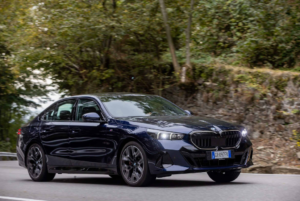
BMW’s flagship SUV, the X7, has undergone a significant update, introducing fresh exterior elements, a modernized interior, and new engine options for the Indian market. With the availability of the xDrive40i and xDrive40d variants, the X7 aims to deliver a compelling driving experience. In this review, we take a closer look at the xDrive40d diesel version.
BMW X7 Exterior Changes
The X7 aligns with BMW’s contemporary design language, featuring LED daytime running lights (DRLs) and LED headlamps integrated into the bumpers. Notably, it retains its distinctive oversized kidney grille.
In the M Sport variant, the air intake boasts a sportier design. The X7’s commanding presence is accentuated by its substantial size, measuring over five meters in length with a wheelbase exceeding three meters.

The 21-inch wheels contribute to its road presence, and the M Sport kit adds M badges and blacked-out window surrounds. At the rear, sleek LED tail-lamps are connected by a prominent chrome strip, and the vehicle retains its split-opening tailgate.
BMW X7 Interior Updates
Stepping inside, a significant transformation is evident on the dashboard. Here, a 14.9-inch touchscreen dominates the center console. This substantial screen replaces physical buttons and controls, including the HVAC functions, which have been seamlessly integrated into the iDrive system.
While the touchscreen offers a myriad of features and customization options, it introduces a degree of complexity that may require some acclimatization.

The iDrive system itself, while feature-rich, may appear complex when compared to the user-friendly and straightforward MBUX system offered by Mercedes-Benz.
However, it brings some unique features to the table. The high-quality 360-degree camera can be employed as a dashcam, recording a comprehensive video of your journey.
The cameras are remarkably crisp, with minimal latency. Additionally, the navigation incorporates an augmented reality (AR) function that guides you with turn-by-turn updates overlaid on the video feed.
Another noteworthy addition is the 12.3-inch digital instrument cluster. It provides an abundance of information and can be customized to suit various driving styles. The center console houses controls for ride height adjustment, drive modes, and a streamlined crystal gear shifter, reducing the visual drama in the cabin.
Furthermore, the X7 now incorporates Advanced Driver Assistance Systems (ADAS). These encompass autonomous braking, lane-keeping assist, and lane mitigation warning. However, it misses out on adaptive cruise control, which may disappoint some potential buyers.
In terms of build quality and materials, the X7 maintains the BMW standard of excellence. Virtually every touchpoint features soft-padded materials, resulting in a premium feel throughout the interior. The seats, while missing a massage function, offer exceptional comfort and a wide range of adjustment possibilities.
In the rear, the X7 features captain seats, although a bench seat version is in the pipeline. The individual chairs offer remarkable comfort and generous space. Passengers in the rear are treated to electric sunshades and vents.
While entertainment screens are not standard, provisions for an iPad with type C ports are available. However, it’s important to note the absence of rear seat ventilation and massage functions, which could be considered a missed opportunity.
Additionally, a control panel at the rear is unavailable, meaning that rear-seat passengers must rely on the chauffeur for adjustments related to media, ambient lighting, or other information. Nevertheless, dual-zone climate control is accessible from the rear, ensuring passenger comfort.
Families who utilize the third row will not be disappointed. The middle row can be effortlessly maneuvered to allow access to the third row.

Inside, there is ample space, even for older children. Moreover, the third row boasts individual climate control and a small sunroof, ensuring a sense of openness and comfort. The flexibility of the middle row permits comfortable seating in the back. Despite accommodating three rows, the boot space remains unchanged and can comfortably accommodate soft bags or a medium-sized cabin bag.
Under The Hood Of BMW X7
Powering the updated X7 in its xDrive40d variant is a new 3.0-liter twin-turbo diesel engine. This robust powerplant produces 340hp and 700Nm of peak torque.
While the X7 may appear to be a formidable performer, it’s worth noting that the xDrive40d variant offers slightly less power compared to the previous xDrive50d iteration.
Nevertheless, the X7’s performance is impressive, with a 0-100kph time of just 5.9 seconds. The 8-speed torque converter automatic transmission remains smooth and responsive, and the inclusion of paddle shifters adds an extra layer of engagement to the driving experience.
Despite the robust performance, the engine maintains refinement levels that are nothing short of excellent. Apart from a slight thrum at low RPMs, the diesel engine remains impressively quiet. The cabin’s insulation, complemented by double-glazed glass, contributes to a remarkably serene driving experience.
BMW X7: Ride and Handling
While the X7 is undeniably an SUV, it offers a more elevated driving position compared to other BMW models. In corners, the vehicle’s weight and bulk become apparent. Nonetheless, it exhibits commendable body control and consistent steering, even if it is on the lighter side.

At lower speeds, the ride feels firm, but as the X7 gains momentum, it delivers a composed and smooth ride. The X7 excels on highways, where the diesel engine’s torque and power characteristics shine. However, it’s essential to note that while ADAS features like autonomous braking and lane-keeping assist are available, the X7 lacks adaptive cruise control.
Price and Verdict
With a price tag of Rs 1.24 crore, the X7 finds itself in direct competition with the Mercedes-Benz GLS. Volvo XC90, Land Rover, Audi. The X7 offers practicality, but opinions on its aesthetics and overall driving experience may vary among prospective buyers.
In summary, the BMW X7 facelift brings a range of updates to the table, but it doesn’t represent a revolutionary leap in design or performance. The value proposition of the X7 may be subject to individual preferences, as some buyers may seek a more compelling package within this competitive luxury SUV segment.


